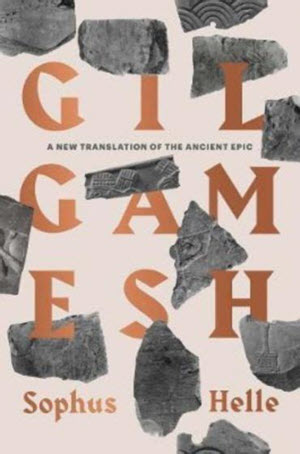Gilgamesh
 You are probably all at least vaguely familiar with the story of Gilgamesh. This, however, it not a review of the epic itself, but rather of one particular translation.
You are probably all at least vaguely familiar with the story of Gilgamesh. This, however, it not a review of the epic itself, but rather of one particular translation.
I should note at the start that Sophus Helle is a friend. He’s been very helpful to my own research on trans lives in ancient Mesopotamia. However, once I explain the value of this translation, I think you’ll understand why I love it.
In the past, translations of Gilgamesh have fallen into two groups. The first are academic works by Assyriologists that tend to be a bit dry and which focus on accurate translation of the original texts. At the opposite extreme we have versions by professional writers who seek to make the text glow, but who know little or nothing about the sources. They work solely from the academic translations.
For example, I have a copy of Stephen Mitchell’s well received 2004 translation. In it, he says:
I don’t read cuneiform and have no knowledge of Akkadian: for the meaning of the text, I have depended on literal translations by seven scholars.
Mitchell is a professional poet, and his bringing his own skills to the job. His version reads very well. But it misses so much about the text.
Helle comes to Gilgamesh via Assyriology. He can read cuneiform. But he’s not disconnected from the literary world either. He cut his teeth on the epic when he produced a version of the text in his native Danish. For that he worked in collaboration with his father, Morten Sødergaard, who is a poet. Helle’s command of English is excellent (rather better than many native-speaking academics), so he is able to render a translation that reads well.
However, in addition he brings to the job an in-depth knowledge of the history of the epic, of the various cultures of ancient Mesopotamia, and in particular of their religions. This is all invaluable. So while the text is good, the really interesting parts of this book are the introduction and the series of essays that follow the main text.
Why is this important? Well to start with, the history of the Epic of Gilgamesh is not simple. We are reasonably sure of the basic text of the Iliad. We believe that it was put in its present form around 300 BCE in Alexandria. The Greek scholars who did that work produced written versions which have been copied down the ages. We have hundreds of complete copies, and while there are differences due to copying errors and idiosyncrasies of individual copyists, the text is broadly the same in all of them.
Contrast Gilgamesh: although it is a story about a Sumerian king, there is no extant Sumerian version. We are not even sure that there was a Sumerian version of the whole epic. Our best guess is that the epic, in its current form, was put together in Babylon a few hundred years after Sargon of Akkad conquered Sumer, possibly assembled from a collection of Sumerian poems about the legendary king. That version would have been written in Old Babylonian. The most complete version we have is written in Standard Babylonian, but that copy was found in the Library of Ashurbanipal and may have been made a few hundred years after the original. There are also versions in Middle Babylonian (found in the Syrian city of Ugarit) and Assyrian. Bits of several versions were found in the Hittite capital of Hattusa, including one translated into the Hittite language. Given that the real Trojans seem to have been a Hittite client kingdom, it is entirely likely that King Priam (if he existed) owned a copy.
None of these copies is complete. Indeed, we still don’t have the entire text. So creating a modern version of Gilgamesh is a bit like trying to piece together the Iliad if all you have to go on are fragments of a version from Rennaisance Italy, Roger Lancelyn Green’s Tales of the Greek Heroes, Madeline Miller’s Song of Achilles, Raoul Schott’s version in German poetry, and the script of Brad Pitt’s movie, Troy.
Knowledge of cuneiform also allows Helle to understand the beauty of the puns, alliteration and so on that can be found in the original(s). This is a work that has been refined over centuries by scribes who would have obsessed over it the way we obsess over Shakespeare. They were smart people, and they did amazing things with the text that an English translation can only approximate.
Understanding of Mesopotamian culture is key to the epic as well. What exactly was the role of a king in Sumer? How much did he have to rely on the good will of the people. What were the social roles of characters such as Shamhat, the priestess, or Shiduri, the tavernkeeper? What does it mean when the text says that Gilgamesh obtained knowledge of “the deep” (the Apsû)? These are all questions that Helle is well-equipped to answer. And because of this, his version of the epic is way more interesting than any literary translation.

Title: Gilgamesh
By: Sophus Helle
Publisher: Yale University Press
Purchase links:
Amazon UK
Amazon US
Bookshop.org UK
See here for information about buying books though Salon Futura